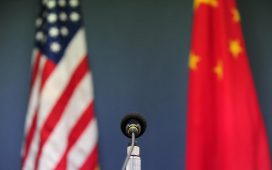Traders react as Federal Reserve Chair Jerome Powell is seen delivering remarks on a screen, on the floor of the New York Stock Exchange (NYSE) in New York City, March 22, 2023.
Brendan McDermid | Reuters
This report is from today’s CNBC Daily Open, our international markets newsletter. CNBC Daily Open brings investors up to speed on everything they need to know, no matter where they are. Like what you see? You can subscribe here.
What you need to know todayÂ
Stocks mixed bag
Wall Street ended Wednesday mixed as investors digested the U.S. Federal Reserve’s minutes from the January meeting. The benchmark S&P 500 gained 0.13%, while the Dow Jones Industrial Average rose 0.13%. But the tech-heavy Nasdaq Composite slid for a third session in a row, closing down 0.32%.
Nvidia shares soar
Shares of Nvidia surged more than 8% in extended trading after the company posted earnings that topped estimates and issued upbeat guidance. The chip giant’s revenue grew a record 265% from a year ago, on robust sales for AI chips for servers.
Fed’s caution
Minutes from the Federal Reserve’s last meeting showed central bank officials expressed caution about lowering interest rates too quickly. Members also emphasized the importance of “carefully assessing” incoming data in judging whether inflation is moving down sustainably to 2%.
Yakuza leader charged
Federal prosecutors in New York charged a Japanese Yakuza leader with nuclear materials trafficking. The accused gangster, Takeshi Ebisawa, “and his confederates showed samples of nuclear materials in Thailand” to an undercover agent from the U.S. Drug Enforcement Administration.
[PRO] Where will yields go?
Given the uncertain path of U.S. interest rates, the question of how it will affect yields and the stock market has been investors’ top focus. Morgan Stanley Investment Management’s Jim Caron weighed in on the issue and noted the 10-year Treasury yield is likely to hover between 5% and 5.5%.
The bottom line
The January minutes made it pretty clear that Fed officials were wary of cutting rates too soon.
While most members believed rates were “likely at their peak,” there was still uneasiness over the inflation picture.Â
The Fed remained “highly attentive” to inflation risks as officials worried whether progress might stall if consumer spending stayed strong.
“As an upside risk to both inflation and economic activity, participants noted that momentum in aggregate demand may be stronger than currently assessed, especially in light of surprisingly resilient consumer spending last year,” the minutes said.
Prior to the meeting, traders had been pricing in a high chance of rate cuts beginning as early as March. That hope has since faded, now most expect the first rate cut to come around the middle of year.
It’s also important to note the meeting was held before the release of the very strong January jobs report and the surprisingly hot consumer and producer price data.
“After those numbers, policymakers will feel vindicated and in even less of a hurry to start easing,” wrote Ian Shepherdson, chief economist at Pantheon Macroeconomics.
“The nature of turning points, however, is that things can change quickly, and we expect the labor market and inflation data by the time of the May meeting to signal that the Fed needs to ease.”
Investors further worry if the central bank maintains an overly restrictive stance for too long that could derail the economy and lead to a bumpier landing.











